Prince
of Wales General Hospital
Tottenham Green East, Tottenham,
N15 4AW
Medical
dates:
Medical
character:
Acute
In 1865 a Dr Laseron decided to
found a hospital where ladies could be trained to nurse the sick poor.
Thus, the Evangelical Protestant Deaconesses' Institution and
Training Hospital opened in a converted cottage in 1867. Its
first Superintendent was a Deaconess from Kaiserwerth (these
Deaconesses also
ran the German Hospital in Dalston).
Mr John Morley, a City merchant, donated a Georgian property - Avenue House on the east side of Tottenham Green - to the Institution and it moved there in 1868.
Avenue House was replaced in 1881 and, in 1887, further extensions were added, including the John Morley Wing. The Prince and Princess of Wales (later King Edward VII and Queen Alexandra) visited the Institution and opened the new buildings.
In 1899 the voluntary Deaconesses were replaced by paid nursing staff. The Institution was renamed the Tottenham Hospital and it became a district general hospital.
In 1907 another extension was opened by King Edward VII and Queen Alexandra and the name was changed to the Prince of Wales General Hospital.
During WW1 the nursing staff dug up part of the 4-acre grounds and create a vegetable garden in which to grow potatoes, cabbages, beans, onions, carrots and other vegetables. They also collected wood to build a chicken shed, intending eventually to keep 200 birds to help with the war effort.
Adjoining property was purchased in 1917 and, in 1923, a further extension opened. This contained a new operating theatre and annexes, and additional ward space for 54 beds. The Nurses' Home was also extended; its floors were sound-proofed and each of the 62 rooms was furnished to a high standard at the cost of £31 each.
On the Hospital staff at this time was a donkey - Nellie - who was a useful member of the institution as well as a great pet.
In 1932 an Out-Patients wing was added, as well as another Nurses' Home. The new buildings were opened by the Prince of Wales (later King Edward VIII and Duke of Windsor).
By 1972 the Hospital had 200 beds.
By the early 1980s 'closure by stealth' had begun, even though assurances had been given by the Ministry of Health that this would not happen. The pathology and microbiology laboratories closed. The Casualty Department closed in 1983, its opening times having been reduced to 10.00-17.00 hr, five days a week; the casualty work moved to an overwhelmed North Middlesex Hospital. The surgical wards were largely empty because of a ban placed on the relatively new operating theatres; only three operating sessions were undertaken out of the ten available. The gynaecological wing also closed, the work having moved elsewhere. Only 45-75 beds in the medical wards were in use.
By 1983 the Hospital had largely closed.
Present status (February 2008)
In 1993 the 4-storey red brick building was converted to provide 38 apartments. It was renamed 'Deaconess Court'. The 2-storey former hospital building to the north was also converted for residential use and is now 2a Elliot Court.
Mr John Morley, a City merchant, donated a Georgian property - Avenue House on the east side of Tottenham Green - to the Institution and it moved there in 1868.
Avenue House was replaced in 1881 and, in 1887, further extensions were added, including the John Morley Wing. The Prince and Princess of Wales (later King Edward VII and Queen Alexandra) visited the Institution and opened the new buildings.
In 1899 the voluntary Deaconesses were replaced by paid nursing staff. The Institution was renamed the Tottenham Hospital and it became a district general hospital.
In 1907 another extension was opened by King Edward VII and Queen Alexandra and the name was changed to the Prince of Wales General Hospital.
During WW1 the nursing staff dug up part of the 4-acre grounds and create a vegetable garden in which to grow potatoes, cabbages, beans, onions, carrots and other vegetables. They also collected wood to build a chicken shed, intending eventually to keep 200 birds to help with the war effort.
Adjoining property was purchased in 1917 and, in 1923, a further extension opened. This contained a new operating theatre and annexes, and additional ward space for 54 beds. The Nurses' Home was also extended; its floors were sound-proofed and each of the 62 rooms was furnished to a high standard at the cost of £31 each.
On the Hospital staff at this time was a donkey - Nellie - who was a useful member of the institution as well as a great pet.
In 1932 an Out-Patients wing was added, as well as another Nurses' Home. The new buildings were opened by the Prince of Wales (later King Edward VIII and Duke of Windsor).
By 1972 the Hospital had 200 beds.
By the early 1980s 'closure by stealth' had begun, even though assurances had been given by the Ministry of Health that this would not happen. The pathology and microbiology laboratories closed. The Casualty Department closed in 1983, its opening times having been reduced to 10.00-17.00 hr, five days a week; the casualty work moved to an overwhelmed North Middlesex Hospital. The surgical wards were largely empty because of a ban placed on the relatively new operating theatres; only three operating sessions were undertaken out of the ten available. The gynaecological wing also closed, the work having moved elsewhere. Only 45-75 beds in the medical wards were in use.
By 1983 the Hospital had largely closed.
Present status (February 2008)
In 1993 the 4-storey red brick building was converted to provide 38 apartments. It was renamed 'Deaconess Court'. The 2-storey former hospital building to the north was also converted for residential use and is now 2a Elliot Court.
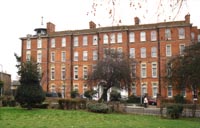
'Deaconess Court'
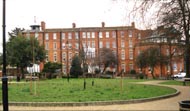
The building, as seen from across Tottenham Green
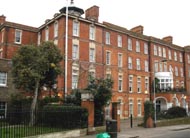
The northwest elevation
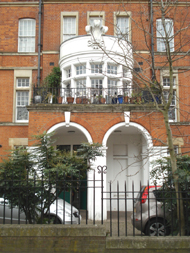
The main entrance - note the Prince of Wales feathers at the top of the balcony
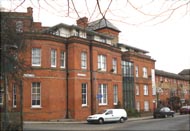
Side elevation in Tynemouth Road
(Author unstated) 1917 Nursing and the war. British Journal of Nursing, 10th February, 97.
(Author unstated) 1924 The Prince of Wales General Hospital, Tottenham. British Journal of Nursing (January), 15.
(Author unstated) 1932 The Prince of Wales Hospital. British Journal of Nursing (July), 189-190.
http://archiseek.com
http://hansard.millbanksystems.com
www.enfield.gov.uk
www.british-history.ac.uk
www.haringey.gov.uk
www.singernet.info
Return to home page